CHAPTER X.
The Small Species of Chorale-Figuration.
90. In the small species the adopted chorale melody (called the cantus firmus) is placed in the uppermost part, as regular Soprano, and in its original metric condition, without extensions or interruptions. The exercises are to be written for the Organ, and therefore the lowermost part is for the Pedal keyboard, while the upper three parts are placed on two staves for the Manual keyboard (generally one, possibly two).
The student who is unfamiliar with the technique of the Organ must first obtain at least a general insight into the treatment of the Manuals and Pedals, before undertaking the present tasks. The only information that can be given here is, that the compass of the pedals is, generally, as follows:

and that the tones of two adjacent manual-parts should always be well within reach of one hand.
Elaborate Harmonization.
91. As the basis of this species of polyphonic texture is again mainly harmonic (see par. 75b), the student had best begin with experiments of a specifically harmonic nature, and make a number of chorale harmonizations, as ingeniously as possible and elaborately as desired, in ordinary 4-part writing (with or without Pedal-bass), after the manner of the following:
Bach, Organ Comp. (Peters compl. ed.), Vol. V, No. 36 (analyze thoroughly); end of No. 53; page 60, I; page 68, I; page 76; page 105. — Further, Vol. V, No. 27.— Vol. VI, No. 26 (5-voice). — Vol. VII, No. 53 (chorale melody extended by rests before and between the lines; imitatory, but not thematic).
Thematic Accompaniment.
92. The number of parts ordinarily employed is four: the cantus firmus, two inner parts, and the Pedal bass.
a. The three lower (accompanying) parts — including the Pedal — are to be thematic; that is, a Motive (or brief Figure of one or two beats) is adopted, and imitated in the usual manner, as contrapuntal harmonization, or Figuration, of the given chorale. The cantus may be written in [quarter]-notes, with a thematic figure (below) in [16th]-notes; or in [half]-notes, with figure in [8th] or [16th]-notes. Or, these values dotted ( or
or  time).
time).
For illustration (beginning of a chorale):
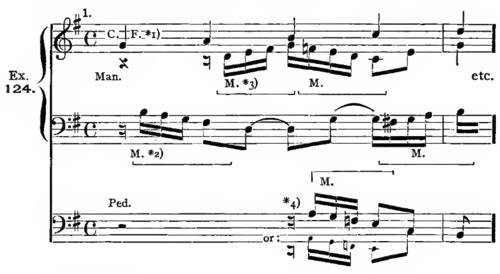

*1) C. F. — the cantus firmus, or given chorale melody.
*2) The Motive, or thematic figure. In this instance it is only one beat long; in the next version it is a genuine “Motive,” two beats in length.
*3) Imitation in contrary motion. Every conceivable device of Imitation may be freely used, in this polyphonic task.
*4) Or an 8ve lower; the Pedal-bass is generally kept fairly low, though it may cross the Tenor occasionally, without objection. See also Ex. 129.
b. The usual harmonic process must be pursued, more or less insistently, in defining the chord-basis of each beat or tone of the cantus firmus; but the effect of the accompanying (figural) voices must be thoroughly polyphonic.
Much liberty may be taken with the adopted Motive; as a rule, it should be present constantly, in some part, in some shape or other, — Ex. 124, Note *3); though it may, briefly, be replaced by episodic fragments, either derived from the M., or independent.
It is not necessary to have a separate chord for each tone of the c.f. The same chord may be held through two successive tones, or more; or the harmony may change within one c.f. tone. Modulations, both diatonic and chromatic, must be freely made, and may be as swift as is compatible with perfect smoothness.
The Pedal-part should be kept somewhat more quiet (sustained) than the inner parts. See also Ex. 124, Note *4).
The end of each “Line” of the chorale is designated by a [fermata]; this, however, merely serves to mark the lines, and is not to be respected, in the Small species, — no check of the rhythmic movement is to occur, anywhere. At the same time, these final tones ([fermata]) should produce a certain cadential impression, and therefore they should, as a rule, be harmonized with some triad, in fundamental form.
At the end, the thematic rhythm runs on, a beat or so (usually in one or both of the inner voices), past the final c.f. tone. Or, better, the final tone may be expanded to a whole measure, or more, while the lower parts effect a plagal ending.
The following illustrations are to be analyzed very thoroughly and minutely:
Bach, Organ Comp., Vol. V, No. 22 (M. in Alto, one beat); No. 48 (M. in Tenor, one beat); No. 33; No. 32 (M. in Pedal, two beats); No. 5; No. 2 (M. in Pedal, two beats); No. 4, verse II (M. in Tenor, four beats); No. 47 (manuals only); No. 31 (M. in Pedal, four beats, divided into two definite figures; inner parts largely episodic).
Table of German Chorales, for Use During This Entire Third Division.
N. B. It is not obligatory to use the keys here given. The chorales may, sometimes must, be transposed to other, higher or lower, keys.

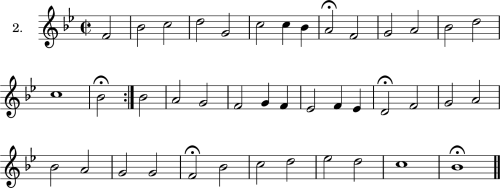
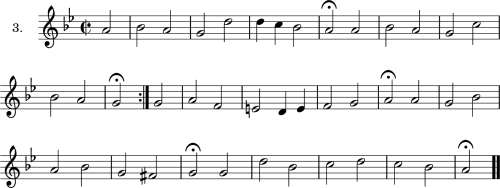

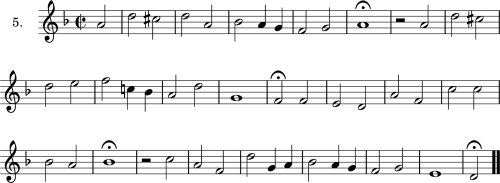

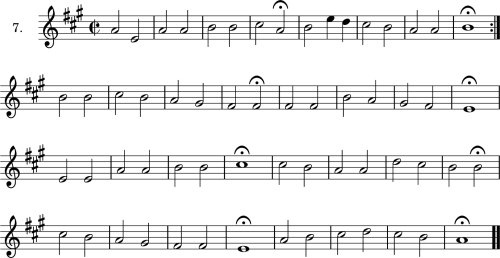




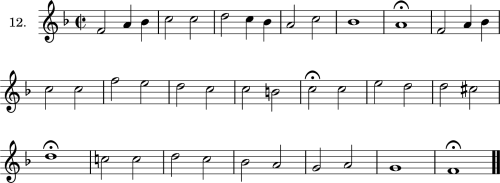

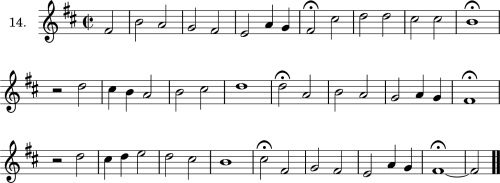
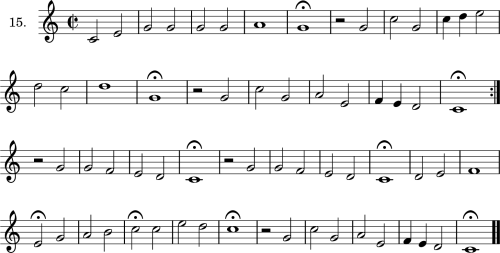
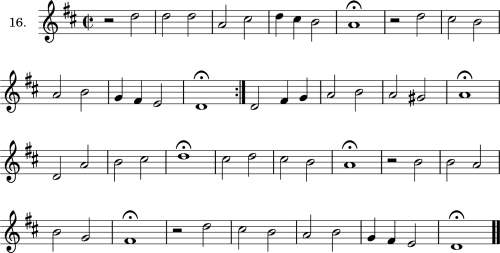
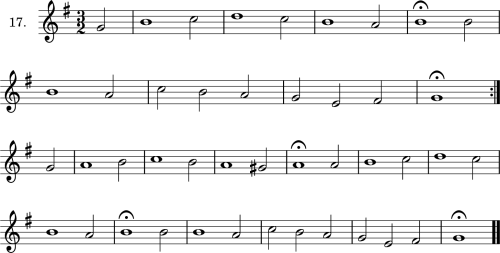
Same as 17, but in ( -measure:
-measure:

A similar transformation of any ( -measure chorale into
-measure chorale into  measure may occasionally be made.
measure may occasionally be made.

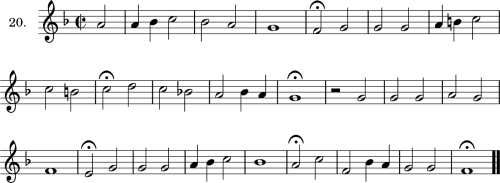
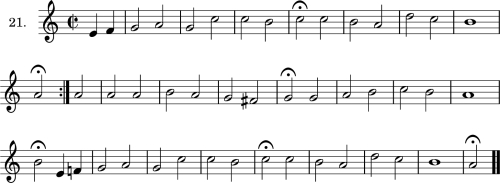

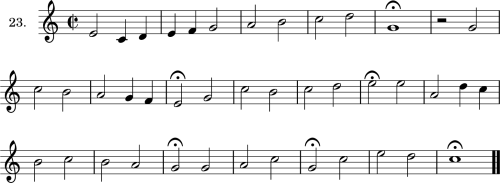


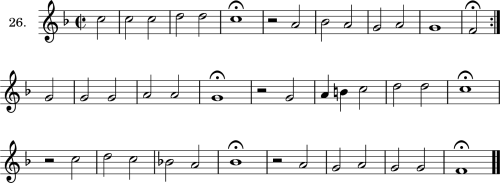


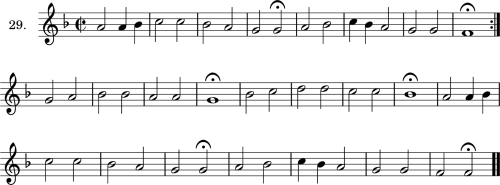

EXERCISE 26.
A. Harmonize a number of the above chorales, according to par. 91. Write the chorale in [quarter]-notes,  or
or  time; limit the accompaniment to [8th]- and occasional [16th]-notes; employ organ-notation (3 staves, including Pedal-bass).
time; limit the accompaniment to [8th]- and occasional [16th]-notes; employ organ-notation (3 staves, including Pedal-bass).
B. Two 4-voice thematic elaborations of No. 1 of the given chorales, with a Figure of one beat and two beats, respectively, according to par. 92a, [par.] 92b. Use  time, and imitate closely the Bach examples.
time, and imitate closely the Bach examples.
C. The 4-voice thematic elaboration of two or more other chorales, in any keys, with a Motive one whole measure in length. The end plagally extended.  ,
,  or
or  time may be used.
time may be used.
Independent Pedal-Part.
93. Partly for the sake of effective variety, and partly on account of the limitations of pedal-technique, it is quite common to conduct the Pedal-bass independent of the inner thematic voices. This is done (1) either by so modifying (simplifying) the Motive as to adapt it better to the character and technique of the pedals; or (2) by adopting an independent (auxiliary) figure for the bass, in more sustained rhythm. See par. 73b; Ex. 119; and the following:
Bach, Organ Comp., Vol. V, No. 1; No. 13 (inner parts thematic, but largely episodic); No. 14; No. 16 (running Pedal-bass); No. 28 (entire Pedal-motive 3 measures long); No. 38 (very characteristic Pedal); No. 40; No. 46; No. 50 (Augm. of Motive, in Pedal; observe rhythmic form of c.f.); No. 54; No. 55 (Pedal-motive, a simplified form of figural motive); No. 56 (M. in Pedal related, but longer); No. 4, Verse 3.
Brahms, “Choral-Vorspiel” (and Fugue) in a minor.
Embellished Cantus Firmus.
94. Although it is characteristic of the present task to restrict the c.f. to the exact form of the original chorale, it is, nevertheless, both natural and desirable (especially in actual practice) to modify certain tones of the given melody by means of unessential passing- or neighboring-notes.
a. Such embellishment of the c.f. may be limited to strictly unessential auxiliary tones, introduced here and there in order to facilitate the thematic development, but not altering or obscuring the original chorale tones. Or it may consist in occasional slight changes of the original even rhythm, by means of dots. For example:

Bach, Organ Comp., Vol. V, No. 22 (already cited); No. 25 (Pedal indep.); No. 49 (ditto); No. 41 (c.f. embellished thematically, i.e., according to figural Motive; Pedal, simplified form of M.); No. 53 (compare with above Table of Chorales, No. 22; the modification of the c.f. oversteps, somewhat, the present limit. Compare, also, with reference to the c.f. only, the preceding and following numbers of Vol. V — Nos. 52 and 54).
b. Or the modification may extend to a systematic ornamentation of the chorale melody, involving all (or nearly all) of the original tones, and resulting often in a richly embellished form of the c.f., to which the lower parts, though usually thematic, appear to constitute a subordinate accompaniment. This variety of elaboration will be considered in detail further on (par. 107).
Motive Derived from Chorale.
95. The motive of the thematic accompaniment may be, and very frequently is, derived from the first line of the c.f.; usually by simple Diminution of the first group of (three or four) tones; or by unessential figuration of them. Thus:


More elaborate forms are shown in Ex. 128
See Bach, Vol. V, No. 21 (contrapuntal associate retained throughout); No. 12 (ditto).
96. Finally, each of the three accompanying (figural) parts may have its own, separate, motive. Each should be sufficiently characteristic, especially in its rhythmic form, that of the Pedal-bass being naturally the most sustained; and they are likely to differ in length. Each part announces its motive independently, and without necessary regard to regular association with the others.
In Bach, Vol. V, No. 9, the following 3 Motives are manipulated, more or less independently of each other:

Analyze the whole number thoroughly, and see also Bach, Vol. V, No. 11 (less thematic than “figural”; Alto and Tenor appear to coöperate in announcing a composite motive, or figure, of one or two beats; the Pedal is independent, and not obviously thematic). — No. 17 (somewhat similar; inner parts coöperate; Pedal plainly thematic).
EXERCISE 27.
A. Write a 4-voice example, with Independent Pedal-part, according to par. 93. Select chorale from the table given in Exercise 26.
B. An example with slightly embellished c.f., as in par. 94a.
C. An example with a Motive one measure long, derived from the c.f.; par. 95.
D. An example with separate M. for each part; par. 96.
Three-Voice Elaboration.
97. When two parts only are added to the c.f., they are most likely to be an inner and lower part for the manual keyboard; though a Pedal-bass is of course possible.
The following specimens are all somewhat peculiar, especially those in which the c.f. is placed in a lower part, instead of in the Soprano. Analyze carefully:
Bach, Vol. V, No. 30 (c.f. in Soprano, slightly embellished; running inner part; Pedal independent). Vol. V, page 81 (Var. VI) — cantus firmus in Pedal-bass. Vol. V, page 86 (Var. IX) — cantus firmus in Pedal, as inner voice; two motives-
Five-Voice Elaboration.
98. For this an Alto, two Tenors, and Pedal-bass are added to the c.f. The motive is apt to be brief, and rests may be freely used. See par. 81.
Bach, Vol. V, page 91 (Var. XI) — Pedal independent; strictly 5-voice, throughout. Vol. V. No. 42 (chiefly 4-voice; c.f. slightly embellished; separate M. for Pedal.)
Miscellaneous. Bach, Vol. V, No. 4, Verse I (two motives together, Double counterpoint, in inner parts; Pedal employs motive 1 exclusively). — No. 6 (c.f. in Alto, slightly embellished; M. two beats, in Soprano; same simplified for Pedal). No. 24 (running Tenor, two alternating motives; Pedal independent; Alto uniform rhythm with c.f.; brief pauses between the Lines). — Brahms, Choral-Vorspiele, op. 122: No. 2; c.f. in Sopr., emb.; 4-voice; indep. Pedal. — No. 5, c.f. in Sopr., 3-voice—fine example. — No. 6, ditto, 4-voice. — No. 8, elab. harmonization; 4-voice, c.f. richly emb.; each Part rep., with c.f. partly in Tenor. — No. 11, ditto; 5-voice; c.f. in Sopr.; end of each line extended by two-fold “echo.” — No. 9; c.f., in Sopr., richly emb.; Ped. independent.
EXERCISE 28.
One or two examples each of the 3-voice and 5-voice chorale elaborations.